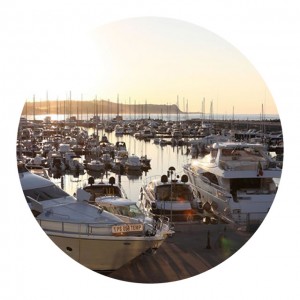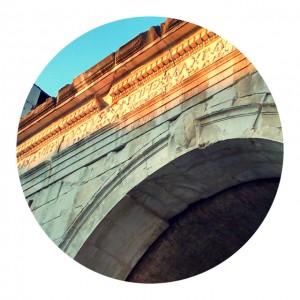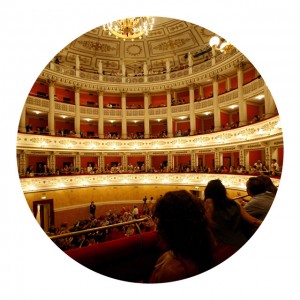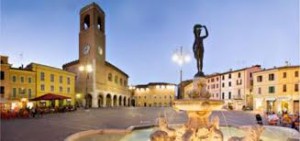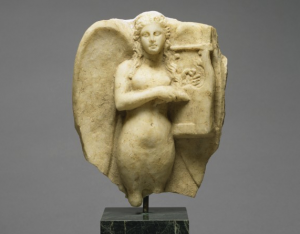Art and culture
Fano is a seaside town, inhabited by fishermen and sailors for centuries. It is nestled between the hills of The Marches and the Adriatic sea. Fano is city of art, proud of its long history and rich in beautiful roman and medieval architecture and works of art. We recommend you to visit the old city centre, the picturesque harbor flanked by colorful fishermen’s houses, the Teatro della Fortuna (Theatre of Fortune) venue for international opera and theatre performances and, last but not least, the guided walking tour into the amazing underground of Fano.
Fano is a historical city and became a part of the Picena civilization. The Piceni built around Fano many tombs and sporadic archaeological finds were discovered in the old town of city as well as on the slopes of Monte Giove and Roncosambaccio.
Fano was an important Roman center too and it was originally known as Fanum Fortunae, a name that refers to the “Temple of Fortuna”, probably erected to witness the Battle of Metaurus in 270 BC when the Roman legions defeated the army of the Carthaginian general Hasdrubal, killing the leader who, after crossing the Alps with elephants, intended to be reunited with his brother Hannibal.
In Roman times Fano was both an important harbor and crossroad. The Romans built here a very important road to Rome, the Flaminia Road, which allowed a direct connection between the Valley of the Tiber River and the Cisalpine Gaul. In 49 BC Gaius Julius Caesar conquered Fano and Pesaro, thus beginning the Civil war against antagonist Pompeo.
Only later Emperor Augustus provided the settlement with boundary walls (still partially visible) and he elevated the settlement to the status of a Roman colony with the name of Colonia Julia Fanestris.
Because of its strategical location, during the Gothic War (6th century) Fano was destroyed and later rebuilt by the Byzantine army of Belisario and Narses.
Fano became then centre of the so called Pentapolis together with Rimini, Pesaro, Senigallia and Ancona. Later on Fano underwent the occupation of the Longobards and the Franks until Otto III donated the town to Pope Silvester II. In the 13th century Fano became municipality and in the following century it was briefly under the Dominion of the Ducal family of Este; after that it was torn by the internal fighting between two families: the Del Cassero and the Da Carignano.
At the end of the 12th century, Fano passed under the domain of the Malatesta, family of Rimini, thanks to a conspiracy hatched by the Malatesta against the two rival families. The Malatesta family remained in power until 1463 when Sigismondo Malatesta had to leave Fano to the Duke of Urbino, Federico da Montefeltro. The population of the town refused to join the Duchy of Urbino and therefore Fano became ecclesiastical Vicariate.
During the Napoleonic occupation, Fano was plundered and bombed by the army of Bonaparte.
Fano participated actively in the motions of the Risorgimento establishing provisional governments.
During the first World War (1915-1918) Fano underwent numerous Austrian naval bombardments. Also during the second World War (1940-1945), lying on the gothic line, Fano was attacked by the Allied aerial forces, which aimed at the destruction of its rail and road bridges. The German army, during its retreat, destroyed most of the bell towers of the city, the civic tower, the donjon of the Malatesta fortress and the fishing port, deemed by the enemy critical infrastructure to not leave into the hands of the Allied.
Come with us and enjoy our amazing tours:
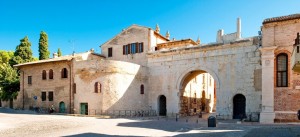
FIRST ITINERARY
Tour without a guide, every week-end:
1st DAY: Start your exploration in the morning at the Arch of Augustus that opens to the cobbled streets of the old town of Fano. Next to the Arch of Augustus is the convent and Church of San Michael. Masses can be attended at 11:00 a.m. at the Cathedral.
Return to the House for lunch.
In the afternoon you can visit the Church of San Pietro in Valle and the tombs of the Malatesta family. The tour may continue at the Cloister and Church of San Paterno.
v Return to the House for dinner.
SECOND ITINERARY
Guided-tour offered by the House:
Every second Saturday of the month at 17.30 a guided tour leads you through the underground area of Saint Agostino. The tour is preceded by a brief presentation of video-projections which illustrate the Roman history of Fano and show the most important monuments of the city.
Pesaro: Is one of the most attractive place in The Marches and it is worth to be mentioned. The town is surrounded by suggestive, hilly panoramas and washed by the Adriatic sea. Pesaro is a popular seaside resort and has a rich cultural and historic heritage (Pesaro is birthplace of Rossini).
Urbino: Whoever comes to Urbino will be amazed by the way the town still preserves and promotes its historic and town planning heritage. Urbino is one of the most complete and refined expressions of the Italian Renaissance and is a UNESCO World Heritage Site. At the same time, the town emerges as a modern center of cultural irridation with an international dimension, partly thanks to its university.
Archaeological Park of Suasa and Roman House: The ancient Roman town of Castelleone di Suasa is well known for its Archaeological Regional Park. The importance of a recent plan of excavations has justified the institution of the Archaeological Park which includes the Roman Amphitheatre, the open-air museum of a Roman House (the Coiedii domus), of great interest because of its size and architectonic complexity. The domus was inhabited over a long period, reaching its maximum splendor in the 2nd century AD. The mosaics discovered in the interior the most important unitary complex of the Marches. Mythological, floral and geometric scenes can be admired, but above all, a magnificent marble floor created with over fifteen different kinds of stone. An avant-garde roofing and super-elevated passageways make the visit easily available.
Sport and nature
The Furlo Gorge, La Gola del Furlo: It is an alternative to a day at the seaside. Strategically located in the green of the Italian Apennines, 50km far from Fano and enclosed by 300-meter-high rock walls, gorges and canyons. It is now a nature reserve. This authentic paradise is crossed by the Via Flaminia, an important trade route which dates back to the third century A.C.
Fracassi Caves, Le Grotte di Frasassi: One of Italy’s most beautiful attractions. The Fracassi Caves are the largest and most famous complex of caves in Europe that extends for about 30 km over eight floors full of stalactites, stalagmites and mineral masterpieces of different sizes and shapes. They are the ideal place for speleologists and nature lovers.
Spirituality
Sanctuary of Don Bosco: In 1943 Pope Pius XI declared Don Bosco a Saint. For this reason Don Luigi Orione and the Sons of Divine Providence decided to erect in Fano a sanctuary in honor of him.
Orfanello, mars 1934: “This is a pretty unenviable pride for Fano, a small and glorious town that precedes bigger and more populated towns in building a sanctuary in honor of Saint Giovanni Bosco”.
The new church was erected near the Monsignor Gentili Orphanage where the poorest young people could find a peaceful residence, food and could benefit from educational and religious formation.
The foundation-stone of the Sanctuary was solemnly laid by Don Luigi Orione, Don Giorgio Serie, Don Carlo Sterpi vicar of Sons of Divine Providence of Fano and the bishop of the town Monsignor Giustino Sanchini.
Fontavellana Monastery: It is located on the wooded flanks of Monte Catria (1701 m), at about 700 meters above sea level. Its origins date back to the end of the first millennium when a group of hermits decided to build here the first cells of an hermitage that would become during the centuries the actual monastery.
From the very beginning, the hermits who lived there, were deeply influenced by the reforms of St. Romuald, founder of the Benedectine Camaldolese Congregation and a major figure of the XX century. He was born in Ravenna and lived in small towns near Fontavellana such as Sitria, San Vincenzo al Furlo and Petrano Mount.
Loreto: It is immersed in the tranquility of the Marches on the top of a hill full of laurel trees (hence tha name of Loreto). The holy town owes its fame to the Sanctuary where the Santa Casa Nazaretana della Madonna (Shrine of the Holy House of the Virgin Mary) is preserved and venerated.
